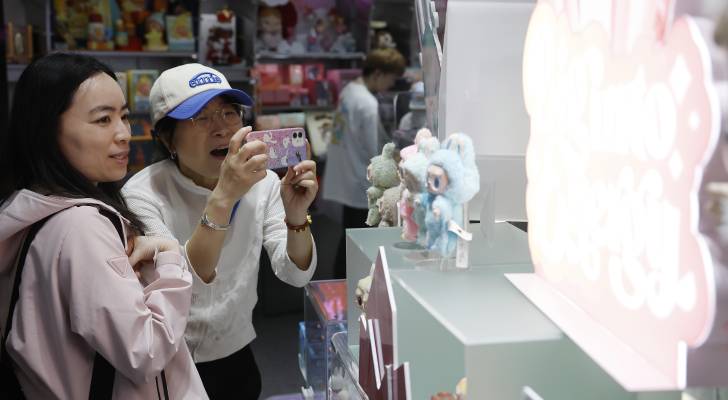Collecting stuffed toys isn’t exactly groundbreaking. But if you’ve noticed a mischievous little elf-monster dangling from someone’s handbag or even a scuffle breaking out in the toy aisle, you’ve probably crossed paths with the Labubu — this season’s unlikeliest It item.
Just ask Manna Wang, a Hong Kong insurance agent who went so far as to hire a college student to hunt them down at any price. In June, that student struck gold: six Labubus priced at HK$99 (about $12.70) each, then flipped for around HK$600 apiece, roughly $77.
“That’s the price I’m willing to pay,” Wang told Bloomberg [1]. “Every time my clients receive the latest version of a Labubu blind box, I hear some happy, excited screaming from either themselves or their kids. They are so excited — everyone desperately wants one, but they’re out of stock.”
That frenzy isn’t limited to Asia. On eBay, Labubu was searched more than 450 times per hour in May. StockX [2] reports Pop Mart sales jumped 748% in the first half of 2025, with Labubu now its top collectibles brand, selling at a 23% premium.
For some collectors, A Pop Mart plush has morphed into more than just a toy — it’s an investment. One ultra-rare edition fetched $150,000 at a Beijing auction [3].
The question now: are Labubus destined to become the next big collectible, or just another bubble waiting to burst?
Pop Mart’s dolls owe a lot of their hype to the mystery box packaging, which keeps fans coming back in hopes of landing a rare one. The company also sells exclusives through its own stores, driving collectors into the resale market. That surge has catapulted founder and CEO Wang Ning’s fortune to $26.2 billion, a 243% jump this year alone, according to the Bloomberg Billionaires Index.
But this isn’t the first time the world has lost its head over plush toys. At the turn of the millennium, Beanie Babies captured the imaginations and opened the wallets of many. Priced at about $5 in the 1990s, their limited availability and retired designs sparked a scarcity-driven mania.
Scoop the Pelican, for example, is considered a holy grail among collectors. Vintage Virtue [4] estimates that a blank-tag version is worth as much as $100,000, while another variation in mint condition with a tag error sold for $9,000 in February 2022.
The Labubu has drawn inevitable comparisons to the Beanie Babies, and for some experts, the parallels are hard to ignore.
“I think it’s very likely to go the same way as the Beanie Babies, but maybe faster, because of course with the Internet, information flows faster,” Christophe Spaenjers [5], a finance professor at the University of Colorado Boulder, told Bloomberg. “There’s probably going to be a handful that are going to hold some value, but most of them are worthless in terms of market value, resale value.”
Still, the Labubu craze lacks what made franchises like Pokémon endure. Pokémon wasn’t just about the toys. It had TV shows, movies, games and a cast of characters that drew consumers into a larger story. Labubu doesn’t have that kind of built-in narrative or media universe to sustain long-term demand.
And the craze is already showing signs of calming down. Pop Mart became a member of the benchmark Hang Seng Index, as well as the Hang Seng China Enterprises Index, which tracks Chinese companies in Hong Kong. Even though Pop Mart’s shares have more than tripled in 2025, they dropped 7% on September 8 [6].
Labubus might feel like déjà vu, but experts warn it’s unlikely to deliver lasting returns. A handful of ultra-rare dolls or early editions may hold value, but most will eventually fizzle once the hype fades.
That doesn’t mean you shouldn’t pick one up if it makes you smile or adds some personality to your bag. But if you’re thinking of Labubus as an “alternative asset,” it may be time to rethink your strategy [7]. Collectibles tend to be more volatile, unpredictable and often driven by hype cycles that collapse faster than they rise.
If you want to protect your money and see it grow, you’re better off sticking with tried-and-true investments. Assets like gold, real estate and even broad-market index funds have decades of data to back them up, compounding steadily over time. They may not come with the thrill of unboxing a mystery plush, but they do offer stability, resilience through downturns and the kind of long-term growth a toy craze simply can’t match.
At Moneywise, we consider it our responsibility to produce accurate and trustworthy content that people can rely on to inform their financial decisions. We rely on vetted sources such as government data, financial records and expert interviews and highlight credible third-party reporting when appropriate.
We are committed to transparency and accountability, correcting errors openly and adhering to the best practices of the journalism industry. For more details, see our editorial ethics and guidelines.
[1]. Bloomberg. “Labubu Is Now a Global Money-Making Machine. Can It Become the Next Disney?”
[2]. Stock X. “StockX’s Midyear Trend Report Has Asics and Salomon Among Fastest-Growing Sneaker Brands; Sees New Records for Labubu and Triple-Digit Sales Growth for Trading Cards”
[3]. CNN. “Rare Labubu sells for more than $150,000 at auction”
[4]. Vintage Virtue. “The Beanie Baby Craze: A Look Back at the 90s Collectible Phenomenon”
[5]. University of Colorado Boulder. “Leeds School of Business: Christophe Spaenjers”
[6]. Investopedia. “Is the Labubu Craze Fading? Maker Pop Mart’s Stock Tumbles After HK Index Entry”
[7]. Investopedia. “Labubu Craze: Just a Toy or Your Next Smart Investment?”
This article provides information only and should not be construed as advice. It is provided without warranty of any kind.


